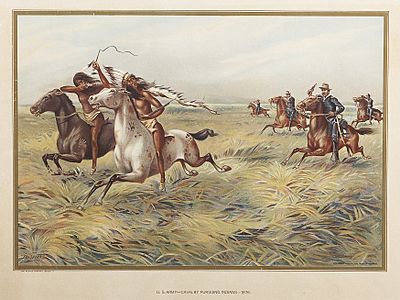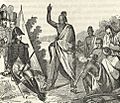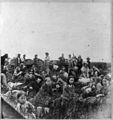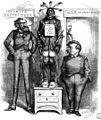American Indian Wars facts for kids
Quick facts for kids American Indian Wars |
|||||||
|---|---|---|---|---|---|---|---|
 An 1899 chromolithograph of US cavalry pursuing American Indians (artist unknown) |
|||||||
|
|||||||
| Belligerents | |||||||
|
American Indians (1540–1924) First Nations (1540–1924) Inuit (1542–1924) Aleut (1743–1924) Yupik (1784–1924)
Provisional Government of Saskatchewan (1885) |
Republic of Indian Stream (1832–1835)
|
||||||
The American Indian Wars (also known as the Indian Wars or the First Nations Wars) were many battles fought in North America. These conflicts happened between different American Indian and First Nation tribes and European, American, and Canadian governments and settlers. They took place from the 1600s until the 1920s.
These wars started for many reasons. People had different cultures and ideas about land. There were also disagreements and conflicts between both sides. Sometimes, European powers and their colonies even asked Indian tribes to help them fight against other colonial settlements.
After the American Revolution, many conflicts were local. They often happened in specific states or regions. These fights were usually about who could use certain land. The British Royal Proclamation of 1763 helped to limit some conflicts in Canada. This rule, which is still part of the Constitution of Canada, said that white settlers could not take land from native peoples without signing a treaty with them. This led to 11 Numbered Treaties being signed in Canada.
As white settlers moved west across America after 1780, the fights between settlers and various Indian tribes became bigger and lasted longer. A major conflict was the War of 1812. This war led to the defeat of large groups of Indian tribes in the Midwest and the South. After this, there were fewer conflicts with settlers, and more treaties were made.
The Indian Removal Act of 1830 allowed the US government to move native peoples from east of the Mississippi River to the west. The government thought this western land was empty. However, many tribes already lived there. Later, the US government changed this policy. Instead of just moving tribes, they started relocating them to special, protected areas called reservations.
Images for kids
-
Siege of Fort Detroit during Pontiac's Rebellion in 1763
-
The abduction of Jemima Boone by Shawnee in 1776
-
Treaty of Fort Jackson with the Creeks, 1814
-
Quanah Parker, son of a Comanche Chief and a Texas settler; his family's story spans the history of the Texas–Indian wars
-
Wagon Box Fight, near Fort Phil Kearny, 1867
-
Custer and Bloody Knife (kneeling left), Custer's favorite Indian Scout
-
Buffalo Soldiers of the 25th Infantry Regiment, 1890
See also
 In Spanish: Guerras Indias para niños
In Spanish: Guerras Indias para niños
















